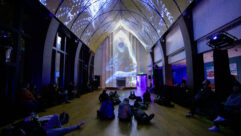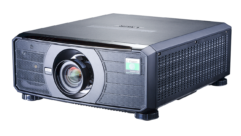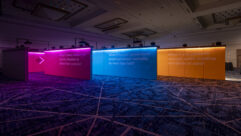A Better Light
IF YOU’VE seen a laser in a boardroom or movie theater, chances are that it was nothing more than a red dot coming from a pointer. But if proponents of laser projection have their way, the technology should start appearing in a variety of consumer and pro AV products by the end of this decade.
Fig. 1: One benefit of laser projection is that it requires fewer components, reducing the cost of the projector or display. For example, by using laser as the light source in a system using Digital Light Processing (DLP) microdisplay technology (See Fig. 2), there’s no need for components such as a color wheel, light tunnel and relay optics.
Fig. 2
IF YOU’VE seen a laser in a boardroom or movie theater, chances are that it was nothing more than a red dot coming from a pointer. But if proponents of laser projection have their way, the technology should start appearing in a variety of consumer and pro AV products by the end of this decade.
“There are some very high-end things that are starting to be fielded now in the simulation market, but that’s not the main focus of what this stuff is going to be,” says Chris Chinnock, president of Insight Media, a Norwalk, CT-based research firm that tracks the AV market. “The area that most people are interested in is consumer TV, and probably in rear projection before front projection.”
Case in point: In February 2006, Mitsubishi Electric showed off what it claims is the world’s first rear-projection TV that uses a laser as its light source. The display features conventional Digital Light Processing (DLP) microdisplay technology, but the light is provided by a trio of red, green, and blue lasers. The company says that the images are 1.8 times more colorful than those of an LCD display. Mitsubishi plans to begin producing commercial versions of the TV by 2008.
Although laser projection is likely to debut on the consumer side, it may not be long before it shows up in pro AV. “We’re seeing huge interest in using this technology for digital cinema,” says Greg Niven, vice president of marketing at Novalux, a Sunnyvale, CA-based company that’s developing laser projection technology. “If you have a cheap laser, you gang them together to increase the brightness — 10,000 or 20,000 lumens — but the projector is the same price as an existing projector.”
Novalux also hopes to make rear-projection displays a viable alternative to LCD and plasma panels, for applications ranging from home theater to digital signage.
“What we feel we’re bringing to the table is the ability to make rear-projection technology, which is the poor cousin right now, competitive with the other flat-panel displays on the market,” says Niven, who joined Novalux from Coherent, another vendor targeting AV applications for lasers. “We want to get a gain-1 or gain-1.5 screen, with 500 nits, with something that’s 4 or 5 inches thick, but it’s actually a projection TV, so it’s light, it’s cheap, and it’s going to have much better color Gamma.”
Killer color
The history of light amplification by stimulated emission of radiation (laser) usually is traced back to 1917, when Albert Einstein proposed a theory for stimulated emission. In 1960, Hughes Research Laboratories demonstrated the first working laser. Today, lasers are widely used in applications ranging from eye surgery to DVD players.
As a light source for projection, lasers have several benefits over the technologies they hope to replace. A major one is color gamut: greater than 200 percent of NTSC levels, according to Novalux. That’s achievable largely because of laser’s waste-not, want-not approach to light. “A laser is basically a fully saturated primary,” Niven says. “It’s an individual wavelength, and 100 percent of the light is in that wavelength.”
The company also says that its laser technology — Novalux Extended Cavity Surface Emitting Lasers (NECSEL) — is wavelength-tunable, so it’s possible to develop multi-primary products instead of just RGB.
“You get much better color saturation and color gamut with LEDs and lasers,” Chinnock says. In its demos, Novalux uses a rainbow on multiple displays, with the other technologies producing rainbows that look washed out compared to the laser projection unit. That type of seeing-is-believing demo could help win over display manufacturers, as well as end-users.
“Ultra-high performance (UHP) lamps and fluorescent tubes don’t have the color Gamma of a cathode ray tube (CRT),” Niven says. “Even the plasma display panels (PDPs) don’t have the color Gamma of a CRT. The laser, though, provides fully saturated primaries, which mean that it’s the theoretical maximum possible color coverage. That’s unknown right now.”
Staying focused
There are already plenty of bright light sources in AV, including UHP lamps, which can exceed the sun’s brightness. Like lasers, some of them — such as LEDs — are solid-state, so their reliability and durability translate into low maintenance. “All the things that apply to that warm-and-fuzzy feeling you get when talking about solid-state lighting applies to our laser source,” Niven says. “It literally is a semiconductor.”
Novalux says that NECSEL is reliable to the point that it was able to qualify for use in telecom networks, where the benchmark is 99.999-percent reliability. “The lasers are much more reliable than anything else, even an LED,” Niven says. “They’re certainly more reliable than UHP lamps.”
But in order to stand out from the pack, lasers have to do more than just match incumbent technologies’ brightness and longevity.
“If you talk about microdisplay-based projection, the laser light characteristics have a ton of advantages over any other type of light source,” Niven says. “Brightness is almost a measure of the quality of the beam propagation of the source. You shine a laser pointer at the moon, and it just goes its merry way. It doesn’t scatter, like an LED or UHP lamp.”
Another potential selling point is a shorter bill of materials (BOM) because using a trio of red, green, and blue lasers eliminates the need for components. For example, in a DLP system, Novalux says that NECSEL eliminates the need for a color wheel, light tunnel, and relay optics. “The laser beam is very, very good,” Niven says. “What that means is you get to use much, much cheaper optics to illuminate the microdisplay and then project it onto the screen.”
At the Consumer Electronics Show in January 2006, Novalux used a demo to prove that lower BOM costs don’t come at the expense of image quality. “We showed a three-LCD engine with a center X cube and a high-temperature poly panel, and that was it,” Niven says. “We just shined the lasers directly into the panel. The laser itself is going to be cheaper than a UHP lamp. On top of that, you’re pulling a bunch of cost from the engine.”
Another potential selling point is that the laser’s highly focused brightness makes it possible to shrink the size of the microdisplay. “With LEDs, they’re larger in light-emitting area than a laser,” Chinnock says. “That becomes a bit of an issue when trying to couple that light into the etendue of the system. You want to make those things as dense and as small and as bright as you possibly can.”
A smaller microdisplay also is a plus from a cost perspective. “That means you can get cheaper microdisplays,” Niven says. “Right now, they can’t shrink microdisplays very much because they can’t collect the light to put on them. A laser gets by that issue completely.”
Coming to light
If lasers have so many advantages, the obvious question is, why aren’t they widely used in consumer and pro AV by now?
A major reason is that although lasers are widely used in dozens of industries, it’s still relatively boutique compared to other technologies. As a result, lasers have a cost premium, which carries over to the products in which they’re used.
“You can make a laser TV today,” says Insight Media’s Chinnock. “There are red, green, and blue lasers out there to do that. The problem is the cost of those lasers.”
That premium puts laser projection at a competitive disadvantage, at least in the eyes of potential customers who are concerned about price. Hence the value of demos that literally show an obvious improvement over incumbent, less expensive technologies, such as LEDs.
Even so, bringing down the cost of laser projection is key to tapping a wider market. “Traditionally the laser makers have been small volume, high engineering value, high performance, and this is a different requirement,” Chinnock says. “Companies like Novalux are trying to change the dynamics of the market.”
Indeed, when Mitsubishi announced its laser-projection TV, the company said that figuring out how to manufacture the system is one of the reasons why it was still nearly two years from commercialization. Novalux seems to have scored a breakthrough on the production front: On March 13, 2006, the company announced that it had licensed its RGB laser reference design to Seiko Epson Corp. for use in microdisplay-based products such as TVs.
Novalux also will provide Seiko Epson with NECSEL semiconductor chips, which the company will integrate with its projection technology.
Neither company said when the Novalux-based products will be commercially available, so it’s unclear whether Seiko Epson or Mitsubishi will be the first to offer laser-projection products for the mass market. Nevertheless, both efforts are signs that the technology is moving in the right direction.
Says Niven, “The gating item is mass producing the laser.”
Tim Kridel is a freelance writer and analyst who covers telecom and technology. He’s based in Kansas City and can be reached at [email protected].










